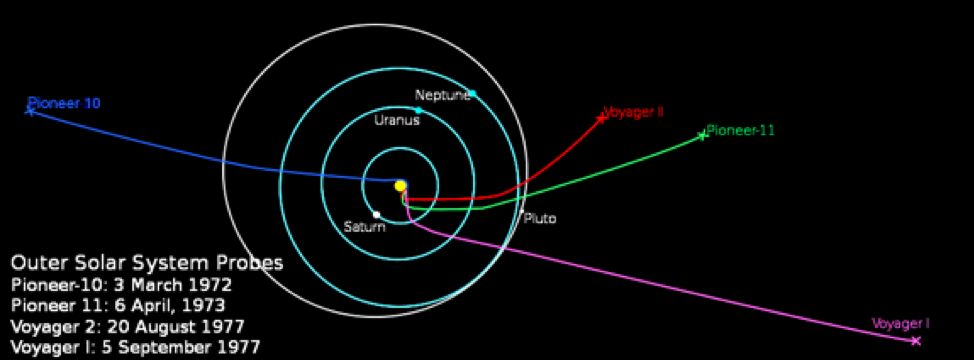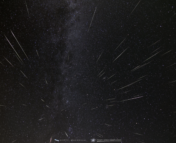
Today’s guest post was written by Matt Joy, a junior at the University of Connecticut, for an assignment in the Fall 2019 Introduction to Modern Astrophysics class taught by Professor Cara Battersby. As part of the course, students were tasked with writing an Astrobite-style essay of an Astrophysics-concept that interested them. Stay tuned for more bites in this series!
Matt is a Mechanical Engineering student and an Air Force ROTC cadet. After graduating, he hopes to be an Air Force Officer and is interested in the applications of Astrophysics for the military.
Aboard the Voyager probes (our most distant spacecraft) lies the following message by former President Jimmy Carter, intended for other intelligent life:“This is a present from a small, distant world, a token of our sounds, our science, our images, our music, our thoughts and our feelings. We are attempting to survive our time so we may live into yours.” (President Jimmy Carter).

Humans are curious creatures. After centuries of observing astronomical phenomena and deriving formulas to predict astrophysical behavior, we’re closer to understanding the processes that govern our universe. Based on our research of potentially life supporting planets, we must now consider what and who may exist in the final frontier. This raises interesting questions regarding how to communicate with species unlike our own and how we ought to present ourselves.
How can we communicate with other intelligent life without using any human language? Human speech developed as a result of our vocal anatomy and our vocabulary developed as a result of our surroundings and culture. Thus, distant intelligent life forms would not speak English or any language native to Earth. However, there is some common ground that is most likely constant throughout the universe. Our laws governing math and physics are thought to be valid anywhere in the universe, so communicating through these is a good starting point. However, our arabic numerals and greek lettering system that we communicate math and physics through is also unknown to distant intelligent life, so we need to communicate in a more universal way. Our base 10 numbering system feels natural to humans, but was likely chosen only because we have 10 fingers, making base 10 counting simple for us. Other intelligent life may not have 10 fingers, and thus not have base 10 counting, so we have chosen the method of binary counting (base 2), the most simple and universal method of counting, in hopes that similar systems exist or can be derived easily by intelligent life. Another difficulty we have in communicating physics concepts with other intelligent life is units. Other intelligent life have no concept of what a meter or a second is since we defined them, so we need to relate these units to something they could measure. One possible method is using astronomical distances and orbital times. If we specify the period of the Earth about the sun, or the distance between the two in our units, other intelligent life can measure these values with their units and establish the conversions. However, this method assumes the intelligent life would be close enough to measure these properties or that the distances and periods would not drastically change between when they are measured. A more universal way to establish our units for time and distance is by using the hyperfine transition of hydrogen, the most abundant element in the universe. Its properties would likely be well understood by intelligent life, and they would be capable of measuring the frequency and wavelength of the radiation given off during the transition. From these measurements we can define a common basis for units.
Now that we know how we could communicate math and physics with other intelligent life, we need to consider what else we would communicate with them. The Voyager Golden Records are two phonographic records sent along with the Voyager spacecrafts into interstellar space.

The records serve as a “time-capsule”, intended for intelligent extraterrestrial life or future humans. The content of the records reflect important facets of human life and the biological variety that inhabits our planet. Astrophysicist Carl Sagan, and many others, meticulously picked images, sounds, and videos to encapsulate the whole of human life and the biodiversity of the planet. The first pictures are scientific in nature, demonstrating our current understanding of math, astrophysics, classical physics, and chemistry. The next pictures depict information about humans; their anatomy, their genetic structure, their reproduction, and their lives. A large cross-section of humanity is sampled in the images, depicting many culture’s rituals, food, entertainment, architecture, and daily-life. The intent was to convey information about all cultures, not just modern American and Western Culture. The record also contains a significant amount of audio. The audio contents contain music of all varieties, including classical, modern (1970s) rock music, cultural folk music, gospel, traditional Eastern pieces, and electronic music. The audio on the record is not limited to music however, but also contains audio of human speech, sounds of the Earth, and even an hour long recording of the brain waves of a woman.
If we know what and how to communicate with other intelligent life, the only question left is, should we? Stephen Hawking famously related us interacting with other intelligent life to the Native Americans interacting with Christopher Columbus. We like to believe we’d be in a position of power when interacting with intelligent life, or at the very least able to protect ourselves and hold our own, but humans are still in the early stages of our technological timeline. Despite these warnings, we’re still making ourselves known in many ways. Our radio waves emit in a sphere around Earth extending a 100 light years in every direction for anyone to tune into. We have sent multiple spacecraft into interstellar space for intelligent life to find. We’re playing a dangerous game, but it is too late now. If intelligent life does ring the cosmic doorbell, it may be in our best interest to pretend no one’s home.




